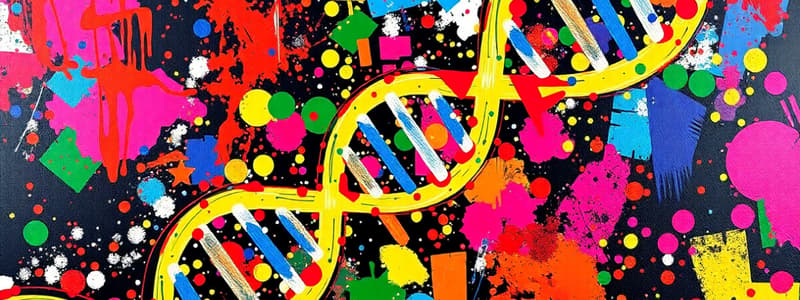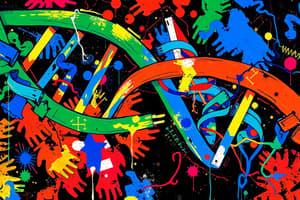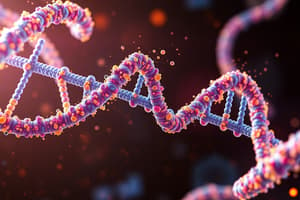Podcast
Questions and Answers
Which of the following nitrogenous bases are purines found in DNA?
Which of the following nitrogenous bases are purines found in DNA?
- Cytosine
- Guanine (correct)
- Adenine (correct)
- Thymine
What is the main structural difference between a nucleoside and a nucleotide?
What is the main structural difference between a nucleoside and a nucleotide?
- Nucleotides are larger than nucleosides due to additional nitrogenous bases.
- Nucleotide sugar can only be ribose, while nucleosides contain deoxyribose.
- Nucleosides contain a sugar and a nitrogenous base, while nucleotides contain a sugar, a nitrogenous base, and a phosphate group. (correct)
- Nucleosides include a phosphate group, and nucleotides do not.
Which sugar is included in DNA nucleotides?
Which sugar is included in DNA nucleotides?
- Glucose
- Fructose
- Ribose
- Deoxyribose (correct)
What is the primary function of the phosphate group in nucleotides?
What is the primary function of the phosphate group in nucleotides?
What type of sugar is found in DNA nucleotides?
What type of sugar is found in DNA nucleotides?
Which of the following statements is true regarding the nitrogenous bases in DNA?
Which of the following statements is true regarding the nitrogenous bases in DNA?
Which nitrogenous base is found in RNA but not in DNA?
Which nitrogenous base is found in RNA but not in DNA?
What type of bond connects nucleotides in a DNA polynucleotide chain?
What type of bond connects nucleotides in a DNA polynucleotide chain?
What is contained in a nucleoside?
What is contained in a nucleoside?
Which nucleotide pairing has the stronger bond in DNA?
Which nucleotide pairing has the stronger bond in DNA?
What type of nitrogenous bases are cytosine and thymine classified as?
What type of nitrogenous bases are cytosine and thymine classified as?
What is the overall charge of DNA and why?
What is the overall charge of DNA and why?
In which direction do the two strands of DNA run?
In which direction do the two strands of DNA run?
What is the structural shape of DNA?
What is the structural shape of DNA?
What is the role of nucleoside analogs like AZT in viral infections?
What is the role of nucleoside analogs like AZT in viral infections?
Which pairing of bases occurs in DNA?
Which pairing of bases occurs in DNA?
Which of these best describes the role of histones in DNA packaging?
Which of these best describes the role of histones in DNA packaging?
How does the presence of uracil in RNA differ from thymine's role in DNA?
How does the presence of uracil in RNA differ from thymine's role in DNA?
What is the key distinction between heterochromatin and euchromatin concerning gene expression?
What is the key distinction between heterochromatin and euchromatin concerning gene expression?
If a strand of DNA includes the sequence 5’-GCTAT-3’, what would be its complementary strand?
If a strand of DNA includes the sequence 5’-GCTAT-3’, what would be its complementary strand?
How do nucleoside analogs like AZT interfere with viral replication?
How do nucleoside analogs like AZT interfere with viral replication?
Transcription describes the process by which a DNA sequence is used to synthesize which type of molecule?
Transcription describes the process by which a DNA sequence is used to synthesize which type of molecule?
The process where tRNA interacts with mRNA to build a specific amino acid chain is typically called
The process where tRNA interacts with mRNA to build a specific amino acid chain is typically called
What role does acetylation of histones play in gene expression?
What role does acetylation of histones play in gene expression?
Which of the following best describes the relationship between a nucleoside and a nucleotide?
Which of the following best describes the relationship between a nucleoside and a nucleotide?
How many hydrogen bonds are formed between guanine and cytosine in a DNA molecule?
How many hydrogen bonds are formed between guanine and cytosine in a DNA molecule?
If a segment of DNA has the sequence 5'-ATGC-3' on one strand, what would be the sequence of the complementary strand?
If a segment of DNA has the sequence 5'-ATGC-3' on one strand, what would be the sequence of the complementary strand?
What is the primary role of histone proteins in DNA packaging?
What is the primary role of histone proteins in DNA packaging?
What is the primary function of histone proteins within a cell?
What is the primary function of histone proteins within a cell?
Which of the following best describes heterochromatin?
Which of the following best describes heterochromatin?
Which structural feature stabilizes the double helix of DNA, in addition to hydrogen bonds?
Which structural feature stabilizes the double helix of DNA, in addition to hydrogen bonds?
Why are nucleoside analogs used in antiviral treatments such as AZT and acyclovir?
Why are nucleoside analogs used in antiviral treatments such as AZT and acyclovir?
What is the effect of histone acetylation on DNA?
What is the effect of histone acetylation on DNA?
How does the structure of a DNA molecule contribute to its function in storing genetic information?
How does the structure of a DNA molecule contribute to its function in storing genetic information?
What is the role of histone deacetylases?
What is the role of histone deacetylases?
What are the repeating units that comprise chromatin?
What are the repeating units that comprise chromatin?
Which nitrogenous base is present in RNA but not in DNA?
Which nitrogenous base is present in RNA but not in DNA?
What is a key structural difference between RNA and DNA?
What is a key structural difference between RNA and DNA?
How does the phosphate group contribute to the function of a nucleotide?
How does the phosphate group contribute to the function of a nucleotide?
What distinguishes Z-DNA from B-DNA?
What distinguishes Z-DNA from B-DNA?
The formation of what type of structures are primarily responsible for the three-dimensional folding of RNA?
The formation of what type of structures are primarily responsible for the three-dimensional folding of RNA?
Where does the process of DNA compaction using histones and nucleosome formation primarily occur?
Where does the process of DNA compaction using histones and nucleosome formation primarily occur?
Which of the following best describes the role of messenger RNA (mRNA)?
Which of the following best describes the role of messenger RNA (mRNA)?
What type of bond connects nucleotides along a strand of DNA?
What type of bond connects nucleotides along a strand of DNA?
Which type of RNA is a component of ribosomes?
Which type of RNA is a component of ribosomes?
Which of the following statements best describes the antiparallel nature of the DNA double helix?
Which of the following statements best describes the antiparallel nature of the DNA double helix?
What is the function of transfer RNA (tRNA)?
What is the function of transfer RNA (tRNA)?
What is the anticodon region of tRNA responsible for?
What is the anticodon region of tRNA responsible for?
What is the role of supercoiling in DNA packaging?
What is the role of supercoiling in DNA packaging?
Why is the ratio of A to T and G to C consistent within a DNA molecule?
Why is the ratio of A to T and G to C consistent within a DNA molecule?
Which of the following is a direct result of the removal of acetyl groups from lysine residues of histones?
Which of the following is a direct result of the removal of acetyl groups from lysine residues of histones?
What is the role of aminoacyl-tRNA synthetase enzymes?
What is the role of aminoacyl-tRNA synthetase enzymes?
Which of the following is NOT a function of the RNA molecule?
Which of the following is NOT a function of the RNA molecule?
In the context of RNA structure, what are hairpin loops, stem-loops, bulges, and internal loops?
In the context of RNA structure, what are hairpin loops, stem-loops, bulges, and internal loops?
Flashcards
Pyrimidine
Pyrimidine
A heterocyclic aromatic organic compound containing two nitrogen atoms in the ring structure, found in DNA, including cytosine and thymine.
Purine
Purine
A heterocyclic aromatic organic compound consisting of a pyrimidine ring fused to an imidazole ring, found in DNA, including adenine and guanine.
Nucleoside
Nucleoside
The basic building block of nucleic acids, consisting of a nitrogenous base and a sugar molecule (deoxyribose or ribose).
Cytosine
Cytosine
Signup and view all the flashcards
Thymine
Thymine
Signup and view all the flashcards
Adenine
Adenine
Signup and view all the flashcards
Guanine
Guanine
Signup and view all the flashcards
Nucleotide
Nucleotide
Signup and view all the flashcards
What is a nucleotide?
What is a nucleotide?
Signup and view all the flashcards
How does DNA store genetic information?
How does DNA store genetic information?
Signup and view all the flashcards
What is the role of the phosphate group in DNA?
What is the role of the phosphate group in DNA?
Signup and view all the flashcards
What are the base pairing rules in DNA?
What are the base pairing rules in DNA?
Signup and view all the flashcards
What is meant by antiparallel strands in DNA?
What is meant by antiparallel strands in DNA?
Signup and view all the flashcards
What stabilizes the double helix structure of DNA?
What stabilizes the double helix structure of DNA?
Signup and view all the flashcards
What is the role of nucleoside analogs in antiviral treatment?
What is the role of nucleoside analogs in antiviral treatment?
Signup and view all the flashcards
How does the number of hydrogen bonds influence DNA stability?
How does the number of hydrogen bonds influence DNA stability?
Signup and view all the flashcards
What are the three components of a nucleotide?
What are the three components of a nucleotide?
Signup and view all the flashcards
What does "antiparallel" mean in relation to DNA strands?
What does "antiparallel" mean in relation to DNA strands?
Signup and view all the flashcards
What is the difference in the sugar molecules between DNA and RNA?
What is the difference in the sugar molecules between DNA and RNA?
Signup and view all the flashcards
What is euchromatin?
What is euchromatin?
Signup and view all the flashcards
What is heterochromatin?
What is heterochromatin?
Signup and view all the flashcards
What are histones?
What are histones?
Signup and view all the flashcards
How do nucleoside analogs work as antiviral drugs?
How do nucleoside analogs work as antiviral drugs?
Signup and view all the flashcards
What are the components of a nucleotide?
What are the components of a nucleotide?
Signup and view all the flashcards
What does it mean for DNA strands to be antiparallel?
What does it mean for DNA strands to be antiparallel?
Signup and view all the flashcards
How do nucleoside analogs work in antiviral treatment?
How do nucleoside analogs work in antiviral treatment?
Signup and view all the flashcards
What are histones and how do they contribute to DNA packaging?
What are histones and how do they contribute to DNA packaging?
Signup and view all the flashcards
What are nucleosomes, and how do they condense DNA?
What are nucleosomes, and how do they condense DNA?
Signup and view all the flashcards
Why is DNA packaging necessary?
Why is DNA packaging necessary?
Signup and view all the flashcards
How does supercoiling contribute to DNA packaging?
How does supercoiling contribute to DNA packaging?
Signup and view all the flashcards
What is the significance of the phosphate group in DNA?
What is the significance of the phosphate group in DNA?
Signup and view all the flashcards
How are DNA nucleotides linked together?
How are DNA nucleotides linked together?
Signup and view all the flashcards
What does the term 'antiparallel' mean in the context of DNA?
What does the term 'antiparallel' mean in the context of DNA?
Signup and view all the flashcards
Describe the structure of DNA.
Describe the structure of DNA.
Signup and view all the flashcards
Heterochromatin
Heterochromatin
Signup and view all the flashcards
Euchromatin
Euchromatin
Signup and view all the flashcards
Histone Acetyltransferases (HATs)
Histone Acetyltransferases (HATs)
Signup and view all the flashcards
Histone Deacetylases (HDACs)
Histone Deacetylases (HDACs)
Signup and view all the flashcards
Messenger RNA (mRNA)
Messenger RNA (mRNA)
Signup and view all the flashcards
Ribosomal RNA (rRNA)
Ribosomal RNA (rRNA)
Signup and view all the flashcards
Transfer RNA (tRNA)
Transfer RNA (tRNA)
Signup and view all the flashcards
Anticodon
Anticodon
Signup and view all the flashcards
Codon
Codon
Signup and view all the flashcards
Translation
Translation
Signup and view all the flashcards
Transcription
Transcription
Signup and view all the flashcards
RNA (Ribonucleic acid)
RNA (Ribonucleic acid)
Signup and view all the flashcards
Ribose
Ribose
Signup and view all the flashcards
Uracil
Uracil
Signup and view all the flashcards
Protein Synthesis
Protein Synthesis
Signup and view all the flashcards
Study Notes
DNA and RNA Composition and Structure
- Nitrogenous Bases: DNA contains two groups:
- Pyrimidines: Cytosine, Thymine; aromatic molecules with two nitrogens in the ring.
- Purines: Adenine, Guanine; aromatic, with a pyrimidine ring fused to an imidazole ring.
- These bases are weakly basic.
- Nucleotide Structure:
- Nucleoside: A nitrogenous base and a sugar (no phosphate).
- Sugar is deoxyribose in DNA and ribose in RNA.
- This combination forms the nucleoside; building blocks of nucleic acids.
- Nucleotide: A nucleoside with a phosphate group.
- The phosphate group gives the nucleotide a negative charge.
- Essential structural and functional unit of nucleic acids (DNA and RNA).
- Nucleoside: A nitrogenous base and a sugar (no phosphate).
- DNA Polynucleotide Chain: DNA nucleotides are linked by phosphodiester bonds, forming a phosphate backbone.
- This arrangement gives DNA an overall negative charge.
- Nucleotide Base Pairing:
- Adenine pairs with Thymine via two hydrogen bonds (A-T).
- Guanine pairs with Cytosine via three hydrogen bonds (G-C).
- The specificity of these pairings maintains the DNA's double-stranded nature.
- Double-Stranded DNA: The two DNA strands run antiparallel (5' to 3' and 3' to 5').
- Double Helix: DNA forms a double helix, stabilized by:
- Hydrogen bonds between base pairs.
- Van der Waals interactions.
- Hydrophobic interactions among the bases.
- This arrangement can occur in different forms (e.g., B-DNA, A-DNA, Z-DNA).
- Nucleoside Analogs: Some analogs, like AZT and acyclovir, can block viral DNA synthesis by substituting natural nucleosides and causing chain termination.
DNA Packaging and Chromatin
- DNA Packaging in the Nucleus: DNA is packaged by winding around histone proteins to form nucleosomes.
- Nucleosomes are further compacted into solenoids and chromatin structures.
- Histones are small, positively charged proteins involved in DNA compaction.
- Histones and Chromatin: Nucleosomes consist of DNA wrapped around histone protein cores.
- Chromatin exists in two forms:
- Heterochromatin: Highly condensed, transcriptionally inactive.
- Euchromatin: Less condensed, more gene expression.
- Chromatin exists in two forms:
- Histone Modifications:
- Acetylation: Weakening the bond between histones and DNA, leading to higher gene expression.
- Deacetylation: Increasing the bond between histones and DNA, leading to lower gene expression.
RNA Types and Functions
- RNA Types:
- mRNA (messenger RNA): Encodes proteins, contains the nucleotide sequence for translation.
- rRNA (ribosomal RNA): Structural component of ribosomes, involved in protein synthesis.
- tRNA (transfer RNA): Delivers amino acids for protein synthesis; anticodon region recognizes mRNA codons, amino acid attachment site.
- Other RNAs: RNA primers, small nuclear RNAs, microRNAs, also have regulatory roles.
- Eukaryotic ribosomes contain four types of rRNA (18S, 28S, 5S, 5.8S) packaged with proteins into two subunits (60S and 40S).
- RNA typically exists as a single-stranded molecule that can fold on itself.
Studying That Suits You
Use AI to generate personalized quizzes and flashcards to suit your learning preferences.
Description
This quiz explores the intricate composition and structure of DNA and RNA, focusing on nitrogenous bases, nucleotides, and polynucleotide chains. Test your knowledge on base pairing and the unique properties of these essential biomolecules.




